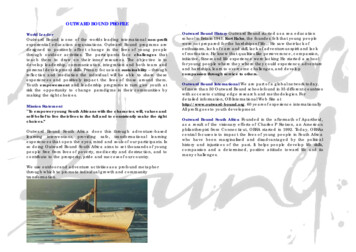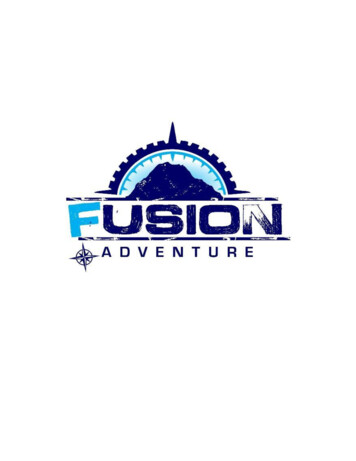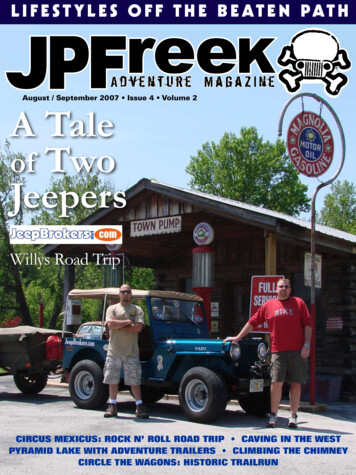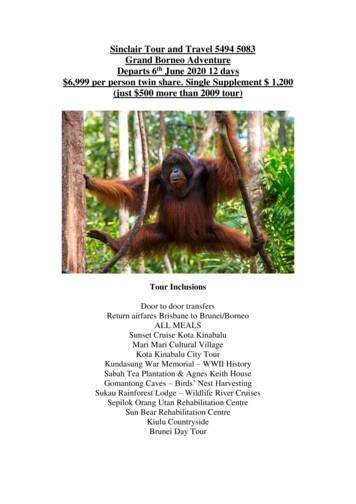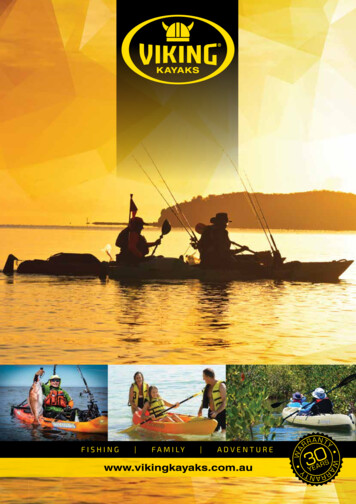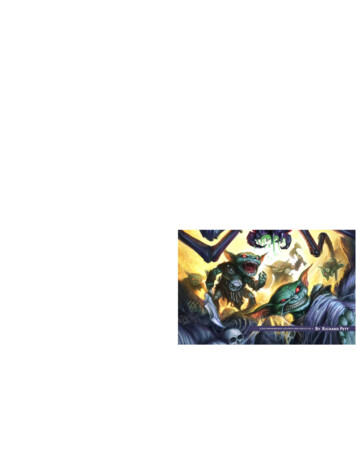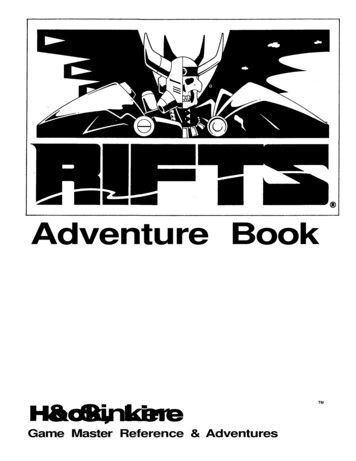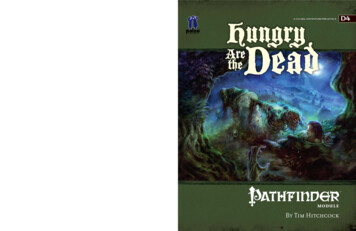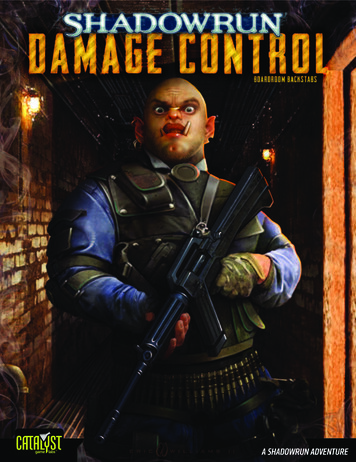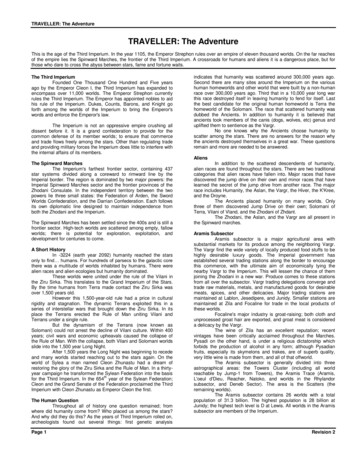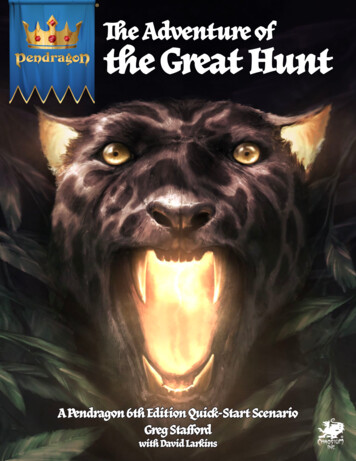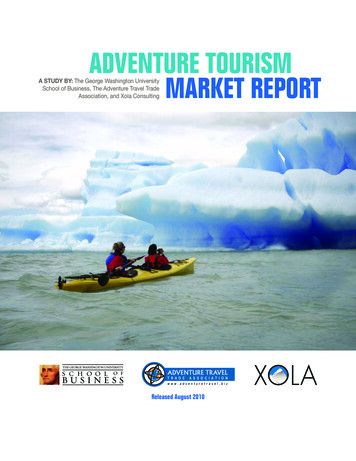
Transcription
ADVENTURE TOURISMMARKET REPORTA STUDY BY: The George Washington UniversitySchool of Business, The Adventure Travel TradeAssociation, and Xola ConsultingReleased August 2010
ContributorsAdventure Travel Trade AssociationShannon StowellChristopher DoyleThe George Washington UniversityKristin Lamoureux, Ph.DPhilippe Duverger, Ph.DNatasha MartinXola ConsultingChristina HeynigerPaige Schneider, Ph.DFor more information about this reportand other adventure industry research,visit and www.xolaconsulting.com.Inquiries may be directed toklam@gwu.educhristina@xolaconsulting.comand info@adventuretravel.biz All rights reserved.ii
Adventure Travel MarketIntroductionThe George Washington University (GW), the Adventure Travel Trade Association (ATTA), and Xola Consulting(Xola) undertook the following study of the Adventure Travel Market in 2009. The goal of the study was to gaina better understanding of the size and characteristics of this important market segment. This profile of theadventure traveler market will be useful to: Government policy makers Destination marketing organizations or destination management organizations, state or national tourism offices Adventure tour operators Gear and equipment companiesMarketing, positioning and branding at the organizational or destination level may be adapted to attract thislucrative segment. Understanding traveler preferences and trends, such as those outlined in this report canimpact the design and development of attractive tourism products and services for this market.OverviewAdventure travelers often seek unique or new travel destinations and activities.It is often believed that a percentage of this sector is willing to accept limitedtourism infrastructure with the promise of an exceptional, authentic experience.Given their penchant for exploring new destinations and seeking new experiences,they are frequently coveted by emerging destinations at the early stages oftourism development and also in more mature destinations that have protectedand/or developed appropriate product.Although adventure tourism is recognized as an important, growing tourismsegment, primary research to quantify the size and scope of this market in theU.S. or internationally (Schneider 2006) has been lacking. For this reason, GeorgeWashington University, along with its partners, the Adventure Travel Trade Association (ATTA) and Xola Consulting, sought to better understand the adventure traveler.This study’s focus area was limited to three major markets: Europe, Latin Americaand North America, which comprise 70% of overall internationaldepartures, according to the UNWTO1.The study focused on previous (actual) and anticipated (intended) travel behavior,as well as psychographic and demographic information. This report providesa detailed examination of adventure travelers in these three areas, including:number of travelers, spending, and a snapshot of predicted future trends.The information in this report may provide guidance for destination managementorganizations and firms involved in marketing as well as product development.It may be especially useful to destination management organizations or state/regional tourism offices seeking to build or enhance their adventure offeringsor adventure tourism operators seeking to understand their target market.The Adventure Travel Market Report includes:Market Sizing Information The size of market and characteristics of adventure travelers in Latin America, North America and Europe,including psychographic and demographic profiles; Analysis of behavioral patterns including their online behavior with a focus on social networking sites; A detailed list of activities/trip types included within the study’s definition of adventure travel; and A snapshot of purchasing patterns for gear, computer and car brands and widely read publications to facilitatea better understanding of their lifestyle.1
Activities included:PhysicalActivityInteraction withEnvironmentCulturalExchangeMethodologyThis study of the adventure travel marketwas conducted in late 2009. Adventuretravel is an inherently subjective activity:what is adventure to one person, maynot be to another2. Therefore, for thepurpose of this study, a broad definitionof adventure tourism was adopted:any domestic or international trip thatincludes at least two of the followingthree aspects: physical activity, interaction with nature and cultural learning orexchange.* Respondents were providedwith a list of possible activities. Theywere asked to choose what activitiesthey had participated in. These activitieswere categorized into either hard or softadventure activities or “other” tourismactivities. This use of this classificationsystem is based on previously established research in this field3. Thiscategorization has its foundation inacademic literature and has beenconfirmed by previous surveys ofconsumers.HardArcheological expeditionsAttending local ingCavingClimbing (mountain/rock/ice)CruiseCultural activitiesCyclingEco-tourismEducational programsEnvironmentally sustainable activitiesFishing/fly-fishingGetting to know the localsHikingHorseback ridingHuntingKayaking/sea/whitewaterLearning a new languageOrienteeringRaftingResearch expeditionsSafarisSailingScuba Walking toursVisiting friends/familyVisiting historical sitesVolunteer TourismUtilizing an on-line survey instrument, zoomerang.com, the surveywas sent to a representative sample of residents. The survey wascompleted by 855 respondents in six countries, in the followingthree regions: Europe, North America and Latin America,representing about 73% of global expenditures or 68.7%of international departures (UNWTO, 2009). The survey wasdistributed to the six countries in the languages outlined tothe venture Travel Trade Association, (2006) adapted from research conducted by Schneider, P. & Vogt, C.(2005). “Adventure Travel Survey: ConsumerReport.” Prepared for the Adventure Travel Trade Association: 1-37.2
The survey sample is statistically representative of the populationunder study5. North American results are less dispersed aroundthe estimates in the population than Latin America or Europeanresults due to the fact that the North American region hosts only3 countries.Respondents’ choice of activity were separated as “hard” or “soft”adventure building on previous research conducted6.Select Key Findings: Of those countries surveyed, 26% of respondents indicated thatthey participated in adventure travel activities; 16% of all international departures from these three regions werefor adventure travel; The choice of activities influence whether consumers term theirtrip ‘adventure.’Adventure Travel Destinations On average, the regional adventure market represents 55% ofadventure travel in the three regions surveyed; The top adventure destinations for developed countries correlatewith those highly ranked on the Adventure Travel DevelopmentIndex. (Learn more at www.adventureindex.travel7)Adventure Travel Expenditures Adventure travel is resilient and is trending upwards even indifficult economic times; Adventure is expanding into a broader range of activities; The “soft” adventurer spends the most per trip, (excluding airfare); The value of the global adventure market is 89billion; All adventure travelers spend significant amounts of money onequipment & apparel pre-trip.Behaviors, Psychographics and Demographics Adventure travelers are equally likely to be single or married, andmale or female. The majority are between 35-47 years old. Industryfollowers familiar with research from the Adventure Travel TradeAssociation may expect a higher percentage of baby boomertravelers. However, this study reflects not only consumers of toursbut adventure travelers in general; it includes people who organizetheir own trips and therefore more likely to be younger with moretime to plan. After “local newspapers,” the most widely read publication byadventure travelers in North America was People Magazine,followed by National Geographic. Compared to “other travelers,” adventure travelers place importance on exploring new places and meeting and engaging withlocal cultures while on vacation; this confirms earlier researchby ATTA which found that travelers were craving more culturalinteraction on trips (ATTA, 2006).* Compared to other forms of pre-trip research, the majority ofadventure travelers (35%) conduct research online, but they alsoconsult friends and family.*Schneider, P., Latkova, P., & Vogt, C. “Consumers’ Need for Uniqueness: Seeking the TraitThrough Adventure Travel.” Travel and Tourism Research Association, 2008.3Top Product CompaniesRecognized by AdventureTravelers1. Timberland2. Quicksilver3. Gore-Tex4. The NorthFace5. Columbia Sportswear6. Montagne7. Eddie Bauer8. Swiss Army Luggage9. Salomon10. LL Bean
Profile of RespondentsWho are adventure travelers? They are fairly evenly split male to female,even within in category of “hard” adventure sports. Soft adventurersskew slightly more female, but not as much as other types of travelerswho are predominantly female (62.3%). The average age of an adventuretraveler is 35 (again, this may seem low from the perspective of adventuretravel tour operators, however, this number reflects the overall adventuretraveler, not just consumers of tours), slightly younger than the “other”traveler who is on average 42.Adventure travelers are more likely to be single or married; less than10% are divorced or separated. They are also more highly educatedthan other types of travelers, with 70% of hard adventures having postsecondary education and 63% of soft adventurers having post-secondaryeducation. 47% of other travelers have a two year degree or higher.Considering these demographic trends, it is unsurprising that adventuretravelers also have higher levels of household income.Interestingly, while many hard adventure travelers clearly view international travel as important (75% have valid passports), among softadventure travelers, only 56.5% have valid passports. From this wecan theorize that among soft adventurers, many are engaging in activitiesdomestically. The table below shows the percentage of adventure travelerswho hold valid passports.HardAdventureTravelersI have a valid passport.75%I do not have a valid passport.25%SoftAdventureTravelers56.5%41.5%Top Magazines BeingRead by AdventureTravelers (US only):1. Local daily newspaper2. People3. National Geographic4. Newsweek5. Time6. Reader’s Digest7. Cosmopolitan8. CondeNast Traveler9. Glamour10. GQOtherTravelers63.7%36.3%These responses indicate that much adventure travel is taking placeregionally, and adventure operators in destinations may considerallocating additional marketing budget to reach their local populationsas well as international markets.What do adventure travelers want when they plan a vacation? Hardadventure, soft adventure and other travelers place a high importanceon similar things when planning their vacations: time to be with friends,time to be with family, relaxation, exciting new activities and learningabout different cultures. However, adventure travelers place a higherimportance on exploring new places, time to be in nature, meetingand engaging with local cultures and pushing their physical limits.Not surprisingly, most adventure travelers are now turning to the Internetto research their trips. When researching a destination, most travelerswill go directly to Google with generic search terms such as the destination name. Over 30% visited the destination’s official website; this maybe because it appeared high in the search results. Around 20% usedsocial media to learn about the destination either by reading a blogpost or viewing a friend’s photos on a social network. The surveyresults reveal that Facebook dominates the social networking space,and targeted ads would best be placed here.Secondary to the Internet, travelers routinely consult friends and familyfor opinions and suggestions on destinations.411.2% of AdventureTravelers own an iPhone
Size of Adventure MarketThe central question is — howmany people are taking adventuretrips? Applying a strict definitionbased on activities done while onvacation, allows an answer to thisquestion to emerge.Types of Travel in Last Three Trips and Intention for Future portion of the PopulationVolume of Adventure TripsIn the past, the definition of whatconstitutes an adventure trip oradventure travel has been illdefined; with influential andrespectable entities disagreeingon what to include or exclude inthe definition. This study’s definitionis based on past literature thatclassified specific activities intotwo segments: hard adventureand soft adventure. In certaininstances, they have beencombined in “all adventure.”66%60%40%20%0%32Hard Adventure1Soft AdventureNext tripOther TravelHard AdventureHard adventure includes trekking, climbing (mountain, rock and ice) and caving8. These activities are highrisk and require a high level of specialized skill. Unsurprisingly, these represented small percentages of thepopulation but still uncovered a sizable market.The trend over the past three years indicates that the number of hard adventure trips has held steady, at around 2% of the population. However, respondents in Latin America and Europe indicated that they intended to take a hardadventure trip for their next vacation. In North America, the trend was opposite, and the percent of people expressing the intention to take a hard adventure vacation dipped slightly.Based on the volumeof Adventure Travel,we estimate that therewill be about 150 millionadventure trips taken inthe next
The “soft” adventurer spends the most per trip, (excluding airfare); The value of the global adventure market is 89billion; All adventure travelers spend significant amounts of money on equipment & apparel pre-trip. Behaviors, Psychographics and Demographics Adventure travelers are equally likely to be single or married, and male or female. The majority are between 35-47 years old .

